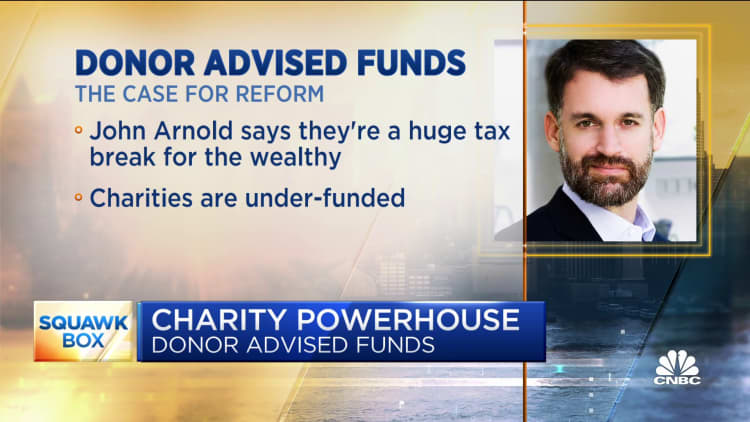
Miniseries | E+ | Getty Images
Anyone watching the markets this year knows that it’s been a bumpy ride.
But investors and the corporate sector aren’t the only ones feeling the pinch as financial markets have fallen sharply. With an estimated 33% of all charitable giving taking place in November and December, non-profit organizations will also be hit by a pullback just as economic uncertainties are increasing demand for their services.
In times of market turmoil, small-dollar contributions tend to remain constant while major charitable gifts decline as wealthy donors feel the effects of a lower-return environment on their portfolios. Still, many high-net-worth donors remain committed to their high-impact philanthropy. For advisors counseling clients like these, there is a smart tool they can use to support non-profit innovation. It’s called a recoverable grant.
A recoverable grant is just what it sounds like — a giving strategy that allows for charitable capital to be “recovered,” typically to a charitable vehicle such as a foundation or donor-advised fund, if the non-profit organization achieves its agreed-upon objectives. This return of capital option enables donors to potentially multiply their charitable impact over many years by reusing the same funds for future grantmaking. It is, quite literally, a gift that has the potential to keep on giving.
The minimum donation size for these grants tends to start around $25,000, well within reach for many high-net-worth philanthropists, although it can run higher depending on the nonprofit recipient and the nature of the project being funded.
These minimums are in place to ensure that the donation is large enough to account for the effort required by the nonprofit to administer, track and report on the grant. There is also typically a one-time fixed fee required at the time the grant is made.

Since recoverable grants are allocated through charitable entities, there are no specific tax implications of the structure and format. Donors can simply take their charitable deduction, if applicable, when the initial gift is made to the charitable entity.
Recoverable grants are ideal in specific circumstances. They are well suited for making “catalytic,” or seed capital grants that allow nonprofits to stretch beyond the direct services these organizations provide day-to-day. Recoverable grants support getting innovative, novel solutions to entrenched problems off the ground, scaling up successful programs, or helping solve acute and temporary funding gaps.
3 considerations if you’re feeling charitable
Donors and their advisors who consider recoverable grants should ensure that at least three key conditions are in place:
- There is a clear use case for the funds. Much like a restricted grant, which can only be spent for the purpose designated by the donor, recoverable grant funds have specific use cases. These funds are typically used to fund specific revenue-generating programs or to fill a short-term gap between when a nonprofit might need to provide services and when funding arrives. For example, if a nonprofit is working to build health centers in underserved areas, the organization could raise funds from donors via a recoverable grant instead of taking on debt financing to fund the building.
- There is a well-documented timeline and milestones for expected repayment. Nonprofits have the option to set expected repayment guidelines. They can be as short as a few months for short-term microloans or as long as a decade for an investment in a new climate change mitigation technology. The nonprofit can also choose how the repayments are handled. They may choose to repay only a portion of the overall funds, installments over a longer period of time; all the funds at once at the end of the project, or all the funds plus a small additional return premium.
Back to the health center example. If the nonprofit anticipates two years to build the facility plus an additional two years for the center to become profitable, the organization may not begin to repay the recoverable grant for four to five years. If the project timeline gets extended, the timeline for potential grant repayment may be extended as well. - There is appropriate infrastructure in place to track and report on the recoverable grant. Recoverable grants are not appropriate for all nonprofits or all types of projects. The organization will need to track how the funds are allocated, the success (or failure) of the project, and report out on progress on a regular basis. The nonprofit will also need to have a well-defined revenue stream to potentially repay the grant — be that revenues from services or, when filling a short-term funding gap, secured pledges for donations that are expected to arrive at a later date.
While recoverable grants provide nonprofits with critical access to capital to scale and innovate, it’s important for donors to remember that these are grants, not investments. So, if the nonprofit doesn’t hit its goals and chooses not to return any of the funds allocated through a recoverable grant, the money converts to a traditional grant. There is no recourse for the donor to recover the funds for additional charitable use if the project doesn’t deliver its objectives.
End-of-year giving conversations are going to be challenging this year. But financial advisors who serve philanthropic families have an overlooked tool at their disposal. Recoverable grants help keep the focus on high-impact philanthropy that drives systemic, long-lasting change. That’s something we can all celebrate this giving season.
— Liz Sessler, chief operating officer of impact investing firm Capshift






